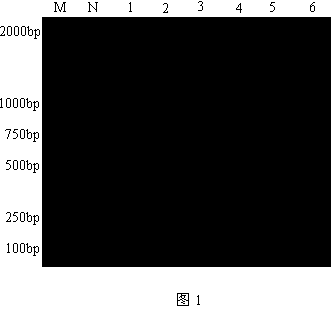Method for detecting five plant viruses synchronously
A technology for simultaneous detection of plant viruses, applied in biochemical equipment and methods, and microbial measurement/inspection, etc., can solve the problems of less research and application of multiplex PCR technology, low accuracy and sensitivity, and long time consumption
- Summary
- Abstract
- Description
- Claims
- Application Information
AI Technical Summary
Problems solved by technology
Method used
Image
Examples
Embodiment Construction
[0032] Get 6 plant samples such as Chinese cabbage, tobacco, tomato, potato, capsicum and pumpkin, detect by the method of the present invention, the result is as follows: figure 2 shown. The type of virus infected by each sample can be clearly determined from the figure, which proves the feasibility and accuracy of the method of the present invention for simultaneous detection of five plant viruses.
[0033] Specific steps:
[0034] (1) Extraction of total RNA
[0035] Take 0.1g fresh leaves from 6 plant samples respectively, according to the kit (RNAiso TM Plus, TaKaRa) method to extract total RNA.
[0036] (2) Multiplex RT-PCR
[0037] Using the extracted total RNA as a template, the first-strand cDNA was synthesized using a reverse transcription kit (PrimeScript RT reagent Kit, TaKaRa Company). The reverse transcription system was 10 μL: 2.5 μL total RNA, 2 μL 5×PrimeScript Buffer, 0.5 μL Oligo dT Primer, 0.5 μL Random 6 mers, 0.5 μL PrimeScript RT Enzyme Mix I, 4 μ...
PUM
 Login to View More
Login to View More Abstract
Description
Claims
Application Information
 Login to View More
Login to View More - R&D
- Intellectual Property
- Life Sciences
- Materials
- Tech Scout
- Unparalleled Data Quality
- Higher Quality Content
- 60% Fewer Hallucinations
Browse by: Latest US Patents, China's latest patents, Technical Efficacy Thesaurus, Application Domain, Technology Topic, Popular Technical Reports.
© 2025 PatSnap. All rights reserved.Legal|Privacy policy|Modern Slavery Act Transparency Statement|Sitemap|About US| Contact US: help@patsnap.com


